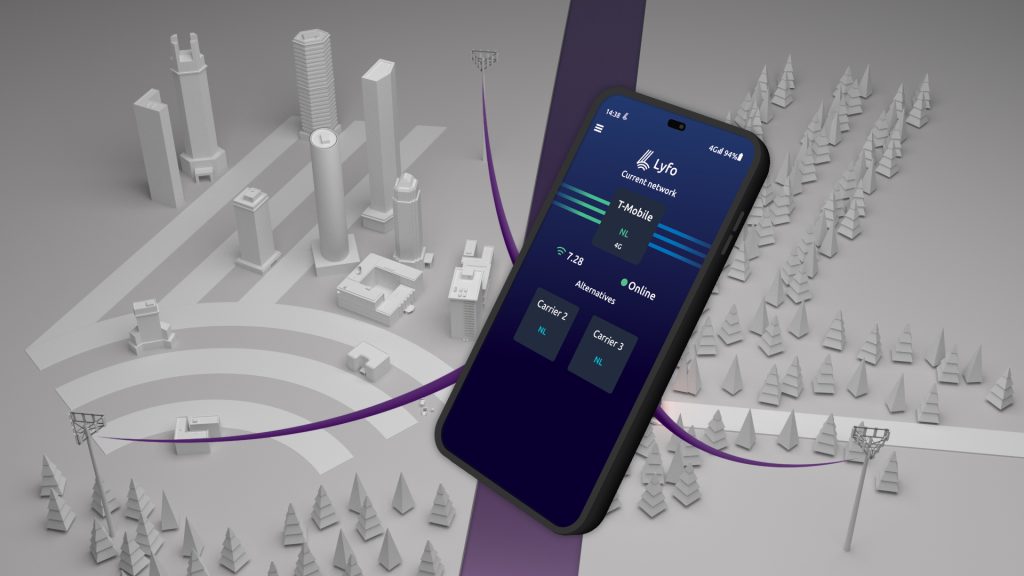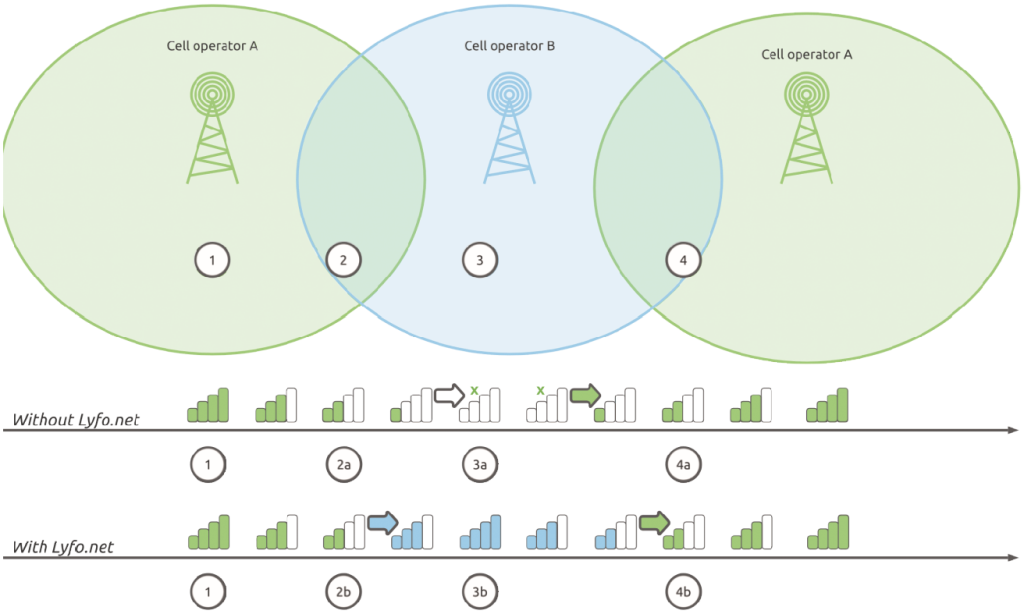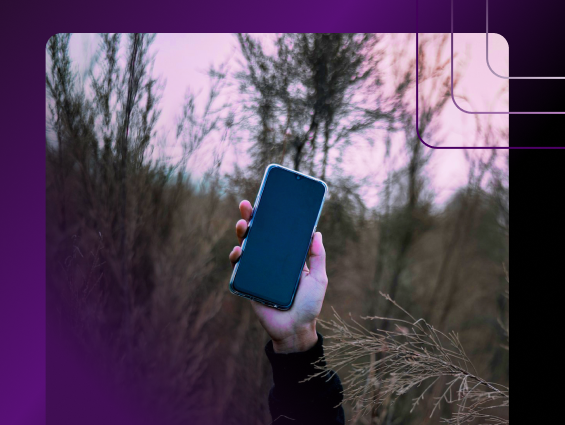
Recently, Lyfo.NET struck an exclusive deal with T-Mobile for Dutch distribution of its solution. The first TBM of 2022 also featured an interesting interview with Maurits van Zandbergen, CEO of Lyfo.NET. In this article, Eildert van Dijken explains how Lyfo.NET works and why it is interesting for the Dutch partner channel.
Mobile networks are designed to stay connected to mobile devices for as long as possible. Fortunately, this ensures that our mobile devices almost always continue to work, by staying connected to their own network. However, there are a few situa- tions in which this is not ideal, namely loss of coverage, roaming, disruption and use of private networks.
don’t have any data connection. Of course, this may be an exception because the mobile networks in the Netherlands are usually very good. The mast locations are often different for each operator though, so each network has a different coverage pattern. Sometimes they still switch back to 2G or 3G, which is fine for reachability, but mobile data is then almost non-existent in my experience.
testing all over again. So, the mobile device is not helped by the network in the border area. You may therefore find yourself on a foreign network for long periods while working in the Netherlands. And at a border crossing, your mobile usually takes longer searching for a network, especially if you’re on the road and driving past new masts all the time. I have often had no data connection for 5 to 10 minutes.
Loss of coverage
No mobile network has complete geographic coverage. Sometimes transmission towers are not permitted, such as in Natura2000 areas. Recently, we took a wonderful walk on the Posbank close to Rheden (near Arnhem). Me and my wife have different network providers and she had coverage on much of the walk, whereas I did not. Since the area was not very familiar to us, it was helpful to use Google Maps. But it doesn’t work very well if you
Roaming
Border areas are also places where mobile devices do not work well. This is unfortunate, because from 2G onwards it has been possible to cross borders with a working connection. Making seamless roaming work well does need a lot of coordination between mobile operators. And that requires a lot of manpower and testing. Because with every change in the radio network (and these changes occur regularly), you have to start
Disruption
Public mobile networks are very complex. Vastly different systems play a role in an operator’s services. In today’s modern networks, redundancy is an important consi- deration. Operators are constantly expanding capacity and adding new features. People
try to implement that (especially at night) as safely as possible. Emergency responders and security personnel in particular sometimes

The Lyfo company was founded by Maurits Zandbergen, who we know from his previous company RadioAccess, then active in Indoor DAS networks and Private GSM and LTE solutions.
That company also experienced the challenges of mobile network availability and being able to roam between the public network and the private network. Through Lyfo.NET, this too is now resolved!
find that there is no network available in a particular area for a while. In addition, adjust- ments are made to the fibre optics, software or configuration
of the networks. And as well as this scheduled work, there are unfortunately other disruptions. Due to external factors, hardware or software problems, the service is not always available. Sometimes the disruption is limited, but it can also last several hours.
Private Networks
A considerable number of organisations,
for example in healthcare, also use private networks. If these are used purely as a DECT replacement with devices remaining on site, there is no problem. But increasingly, people want to remain reachable off-site with the same device. Now there are many devices with dual sim capabilities, but mostly users really need to understand what they are doing to be seamlessly connected inside and outside the network.
How does it work?
Lyfo.NET has developed two pieces of software to enable the switch to take place: a
piece of software on the sim (a sim applet) and an app for the user. Only when you combine the two there is sufficient control over the mobile device for the rapid switch to occur. Because in the background information is continuously being collected on the other available networks, something a device does not normally do.
The switch is based on a Network Quality Indicator (NQI), something developed by Lyfo.NET. This includes radio coverage, as well as IP data transfer rate. There are other parameters, but because of patents, Lyfo. NET does not want to elaborate on them. Some networks do have good coverage, but due to interference or overload, for example, insufficient data transfer speed is available. For example, Lyfo.NET switches as soon as the data rate is 5 Mbit/s or lower.
TwinSIM solution
What Lyfo.NET launched this year is a smart solution that can switch between networks very quickly without users suffering from disruptions. The primary sim is from T-Mobile, the secondary sim is from Lyfo.NET. With Lyfo.NET, it is possible for administrators to choose how the switch should occur for all users in the organisation. In case of coverage problems, in the border area or due to disruptions (see box ‘Demo Effect’), Lyfo.NET ensures that users remain connected.
The image above shows this graphically. Without Lyfo.NET, a user at point (3a) will no longer have a connection. Shortly thereafter, there is network coverage again, so that at
point (4a) there is connection again. With Lyfo. NET, based on the NQI, it already switches to the alternate network shortly after point (2b), so that the data connection is maintained. At point (4b) it then switches back again, once the coverage and data transfer rate are good enough. During testing, many users did not even notice they had switched, despite having changed networks as many as 10 times during their working day. Seamless switching is also perfect for organisations that want
to get the most out of their private network without burdening users with the technology.
Demo Effect
While Lyfo.NET engineers were busy giving a demo, the switch to one of
the three public networks failed. The application just wouldn’t switch. The first thought, of course, was that we were dealing with the Demo Effect – if you want to demonstrate something, it just breaks down. But that was not the case here. The following day, we discovered that the network in question was indeed experiencing a nationwide disruption that afternoon. The application simply would not switch because this network did not provide a good connection. The radio signal was available, but there was a fault at a data centre that prevented IP traffic. So it really works!

Test TwinSIM
During a test of the TwinSIM solution with professional users in rural areas
and near the border, the feedback was extremely positive. Thanks to the second Lyfo SIM, users remained continuously connected while working. In one extreme case, the user had sent nearly 50%
of their data via the second SIM. On average, about 13% of data traffic was handled by the Lyfo SIM. So in more than 1 in 8 situations, the Lyfo SIM was handy to have around. The impact on user satisfaction was huge! Instead of regular complaints or inconvenient situa- tions during operations, users were able to carry out their work normally. They
no longer had to worry about whether they could connect. After the test, users didn’t want to return the SIM either!
Since using Lyfo.NET on their mobile devices, not a single alarm call has been lost
In practice
Lyfo is already being used by a number of customers at home and abroad. Especially within organisations where mission-critical communication is key. For example, Lyfo.
NET was recently rolled out at a large health care institution in the north of the country. The institution experienced continuous coverage problems, despite having equipped employees with the best SIM for their specific work area; a mix of T-Mobile, KPN and Vodafone SIM cards. However, alarm calls continued to go missing, with all the consequences of such
an escalation. Since they are using Lyfo.NET on their mobile devices, not a single alarm call has been lost. Lyfo.NET is therefore a great addition for all Telecom parties that use (health care) alarms over public networks.lvinar dapibus leo.
Conclusion
From an international perspective, the Nether- lands has the best mobile networks in the world. Maybe that’s why we have extra-cri- tical users. Lyfo.NET has very cleverly solved some of the problems of mobile connectivity. Thanks to its agreement with T-Mobile (which certainly did not happen overnight), there
is now also security for larger organisations when choosing this solution. There are already organisations in health care and security services rolling out this solution as a standard for their employees. I therefore think we are going to see Lyfo.NET in a lot of places!
Source : TBM December 2022
Read the full article in PDF




